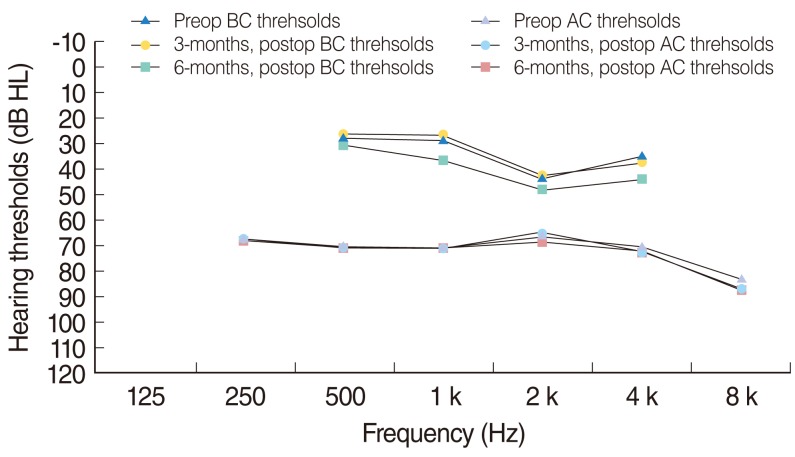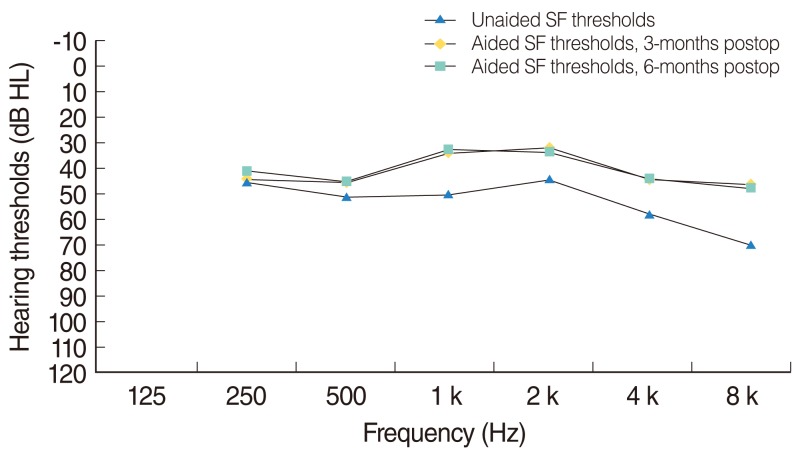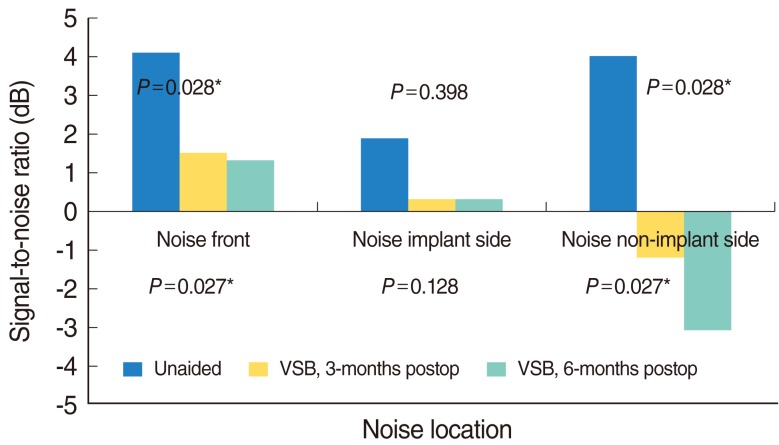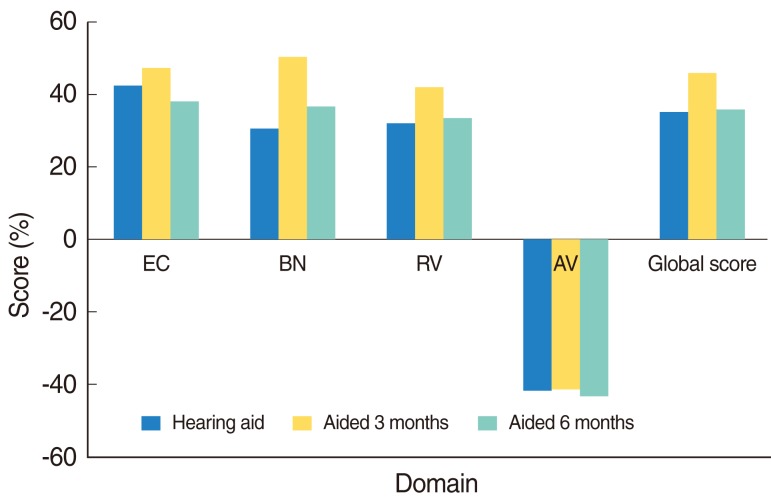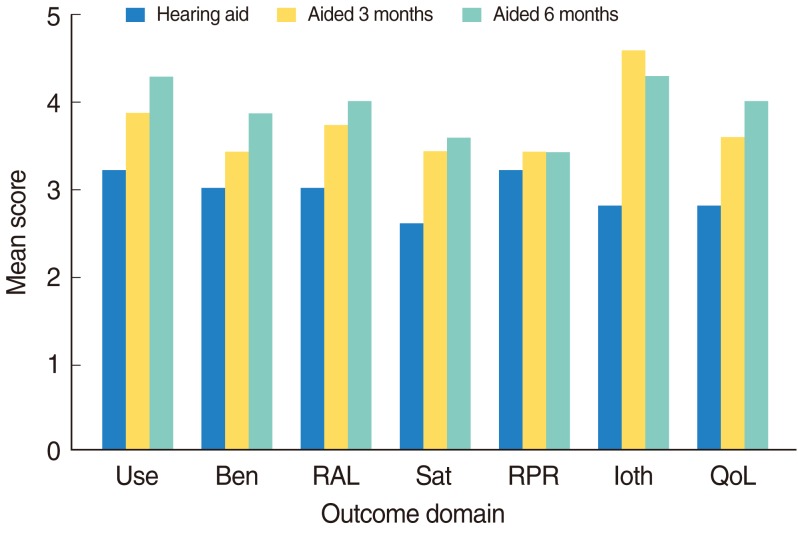Clin Exp Otorhinolaryngol.
2012 Apr;5(Suppl 1):S82-S88.
Outcome of Vibrant Soundbridge Middle Ear Implant in Cantonese-Speaking Mixed Hearing Loss Adults
- Affiliations
-
- 1Department of Otorhinolaryngology, Head and Neck Surgery and Institute of Human Communicative Research, The Chinese University of Hong Kong, Hong Kong. mtong@ent.cuhk.edu.hk
Abstract
OBJECTIVES
To investigate the aided benefits, speech recognition in quiet and in noise, change in hearing and subjective report of satisfaction on mixed hearing loss adults implanted with Vibrant Soundbridge (VSB) middle ear implant.
METHODS
Eight Cantonese speaking adult patients with mixed hearing loss were enrolled in a single-subject, repeated measures prospective study design. Audiometric testing, including air and bone conduction and word recognition under sound-field were conducted before surgery. Device activation was arranged 8 weeks after operation. Audiometric testing was taken to evaluate the change in hearing. Patients were asked to wear the device and come back for fine tuning as needed. Outcome measurements were undertaken at 3 and 6 months after device activation. The outcome measures included sound-field thresholds, Cantonese Hearing in Noise Test (CHINT), Abbreviated Profile of Hearing Aid Benefit (APHAB) and International Outcome Inventory for Hearing Aids (IOI-HA).
RESULTS
The application of the VSB improved the aided thresholds and improved speech intelligibility in quiet and noise without significant changes in hearing thresholds.
CONCLUSION
VSB is considered as a safe, effective and reliable auditory rehabilitation option for Cantonese speaking adults with mixed hearing loss.
MeSH Terms
Figure
Reference
-
1. Tjellstrom A, Lindstrom J, Hallen O, Albrektsson T, Branemark PI. Osseointegrated titanium implants in the temporal bone. A clinical study on bone-anchored hearing aids. Am J Otol. 1981; 4. 2(4):304–310. PMID: 6894824.2. Macnamara M, Phillips D, Proops DW. The bone anchored hearing aid (BAHA) in chronic suppurative otitis media (CSOM). J Laryngol Otol Suppl. 1996; 21:38–40. PMID: 9015447.
Article3. Soo G, Tong MC, Tsang WS, Wong TK, To KF, Leung SF, et al. The BAHA hearing system for hearing-impaired postirradiated nasopharyngeal cancer patients: a new indication. Otol Neurotol. 2009; 6. 30(4):496–501. PMID: 19415040.4. Flynn MC, Sadeghi A, Halvarsson G. Baha solutions for patients with severe mixed hearing loss. Cochlear Implants Int. 2009; 10(Suppl 1):43–47. PMID: 19195004.
Article5. Baumgartner WD, Boheim K, Hagen R, Muller J, Lenarz T, Reiss S, et al. The vibrant soundbridge for conductive and mixed hearing losses: European multicenter study results. Adv Otorhinolaryngol. 2010; 69:38–50. PMID: 20610913.
Article6. Colletti V, Soli SD, Carner M, Colletti L. Treatment of mixed hearing losses via implantation of a vibratory transducer on the round window. Int J Audiol. 2006; 10. 45(10):600–608. PMID: 17062502.
Article7. Bauer RS, Benedict PK. Modern Cantonese phonology. 1997. Berlin: Mouton de Gruyter.8. Wong LL, Soli SD. Development of the Cantonese Hearing In Noise Test (CHINT). Ear Hear. 2005; 6. 26(3):276–289. PMID: 15937409.
Article9. Cox RM, Alexander GC. The abbreviated profile of hearing aid benefit. Ear Hear. 1995; 4. 16(2):176–186. PMID: 7789669.
Article10. Kam AC, Tong MC, van Hasselt A. Cross-cultural adaptation and validation of the Chinese abbreviated profile of hearing aid benefit. Int J Audiol. 2011; 5. 50(5):334–339. PMID: 21271802.
Article11. Cox RM, Stephens D, Kramer SE. Translations of the International Outcome inventory for Hearing Aids (IOI-HA). Int J Audiol. 2002; 1. 41(1):3–26. PMID: 12467365.12. Beltrame AM, Martini A, Prosser S, Giarbini N, Streitberger C. Coupling the Vibrant Soundbridge to cochlea round window: auditory results in patients with mixed hearing loss. Otol Neurotol. 2009; 2. 30(2):194–201. PMID: 19180678.
- Full Text Links
- Actions
-
Cited
- CITED
-
- Close
- Share
- Similar articles
-
- A Case of Middle Ear Implantation Using the Vibrant Soundbridge in a Patient with Bilateral Mixed Hearing Loss
- Two Cases of Middle Ear Implantation: Incus Vibroplasty
- A Case of the Vibrant Soundbridge Stapes Coupler in Patients with Mixed Hearing Loss
- A Case of Incus Vibroplasty: Postoperative Changes in Residual Hearing
- Otologic Active Middle Ear Implants

